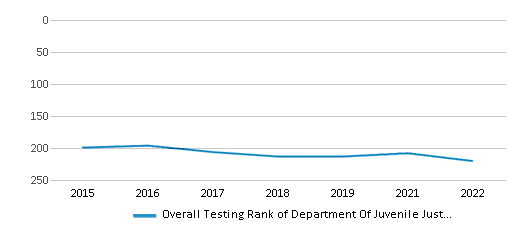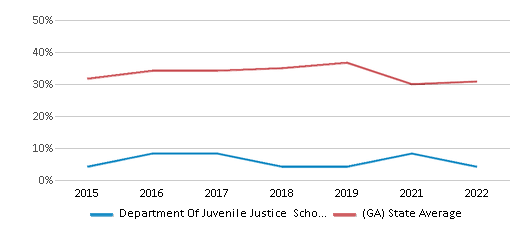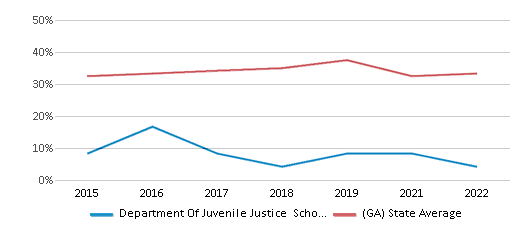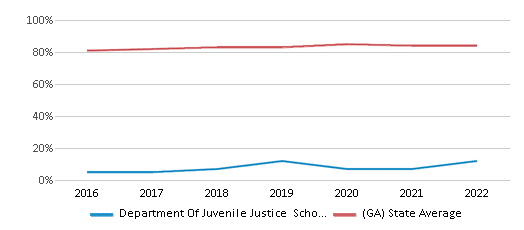Top Rankings
Department Of Juvenile Justice School District ranks among the top 20% of public school district in Georgia for:
Category
Attribute
Student Attention
Lowest student:teacher ratio (Top 1%)
For the 2025 school year, there are 28 public elementary schools serving 422 students in Department Of Juvenile Justice School District. This district's average elementary testing ranking is 5/10, which is in the bottom 50% of public elementary schools in Georgia.
Public Elementary Schools in Department Of Juvenile Justice School District have an average math proficiency score of 34% (versus the Georgia public elementary school average of 38%), and reading proficiency score of 34% (versus the 39% statewide average).
Minority enrollment is 83% of the student body (majority Black), which is more than the Georgia public elementary school average of 65% (majority Black).
Overview
This School District
This State (GA)
# Schools
28 Schools
1,900 Schools
# Students
422 Students
1,207,854 Students
# Teachers
105 Teachers
88,065 Teachers
Student : Teacher Ratio
4:1
4:1
District Rank
Department Of Juvenile Justice School District, which is ranked within the top 50% of all 222 school districts in Georgia (based off of combined math and reading proficiency testing data) for the 2021-2022 school year.
The school district's graduation rate of 10-14% has decreased from 5% over five school years.
Overall District Rank
#220 out of 222 school districts
(Bottom 50%)
(Bottom 50%)

Math Test Scores (% Proficient)
≤5%
37%

Reading/Language Arts Test Scores (% Proficient)
≤5%
40%

Science Test Scores (% Proficient)
6-9%
40%

Graduation Rate
10-14%
84%

Students by Ethnicity:
Diversity Score
0.41
0.72
# American Indian Students
1 Student
2,852 Students
% American Indian Students
n/a
n/a
# Asian Students
n/a
59,894 Students
% Asian Students
n/a
5%
# Hispanic Students
24 Students
223,736 Students
% Hispanic Students
6%
19%
# Black Students
317 Students
437,141 Students
% Black Students
75%
36%
# White Students
71 Students
420,125 Students
% White Students
17%
35%
# Hawaiian Students
n/a
1,175 Students
% Hawaiian Students
n/a
n/a
# Two or more races Students
9 Students
62,424 Students
% of Two or more races Students
2%
5%
Students by Grade:
# Students in PK Grade:
-
48,709
# Students in K Grade:
-
117,257
# Students in 1st Grade:
-
124,992
# Students in 2nd Grade:
-
128,523
# Students in 3rd Grade:
-
125,808
# Students in 4th Grade:
-
127,364
# Students in 5th Grade:
-
128,693
# Students in 6th Grade:
3
129,323
# Students in 7th Grade:
14
127,930
# Students in 8th Grade:
39
127,602
# Students in 9th Grade:
166
6,366
# Students in 10th Grade:
131
5,738
# Students in 11th Grade:
47
5,192
# Students in 12th Grade:
22
4,357
# Ungraded Students:
-
-
Best Department Of Juvenile Justice School District Public Elementary Schools (2025)
School
(Math and Reading Proficiency)
(Math and Reading Proficiency)
Location
Grades
Students
Rank: #1 - 21. - 2.
Atlanta Youth Development Campus
Special Education School
(Math: <50% | Reading: <50%)
Rank:
Rank:
8/
Top 30%10
5651 Stonewall Tell Rd
Atlanta, GA 30349
(404) 656-4522
Atlanta, GA 30349
(404) 656-4522
Grades: 5-12
| 12 students
Rank: #1 - 21. - 2.
Augusta Youth Development Campus
Alternative School
(Math: <50% | Reading: <50%)
Rank:
Rank:
8/
Top 30%10
3481 Mike Padgett Hwy
Augusta, GA 30906
(706) 792-7521
Augusta, GA 30906
(706) 792-7521
Grades: 5-12
| 28 students
Rank: #33.
Macon Youth Development Campus
Alternative School
(Math: ≤20% | Reading: <50%)
Rank:
Rank:
6/
Top 50%10
4160 Riggins Mill Rd
Macon, GA 31217
(478) 751-3432
Macon, GA 31217
(478) 751-3432
Grades: 5-12
| 19 students
Rank: #44.
Eastman Youth Development Campus
Alternative School
(Math: <50% | Reading: ≤20%)
Rank:
Rank:
5/
Bottom 50%10
176 Freaman Graham Blvd
Eastman, GA 31023
(478) 374-6910
Eastman, GA 31023
(478) 374-6910
Grades: 5-12
| 34 students
Rank: #55.
Muscogee Youth Development Campus
Alternative School
(Math: ≤20% | Reading: ≤20%)
Rank:
Rank:
2/
Bottom 50%10
7700 Chattsworth Rd
Midland, GA 31820
(706) 569-2863
Midland, GA 31820
(706) 569-2863
Grades: 5-12
| 43 students
Rank: n/an/a
Aaron Cohn Regional Youth Detention Center
Alternative School
7700-b Chattsworth Rd
Midland, GA 31820
(706) 568-2498
Midland, GA 31820
(706) 568-2498
Grades: 5-12
| 17 students
Rank: n/an/a
Augusta Regional Youth Detention Center
Alternative School
3485 Mike Padgett Hwy
Augusta, GA 30906
(706) 771-7854
Augusta, GA 30906
(706) 771-7854
Grades: 5-12
| 17 students
Rank: n/an/a
Bob Richards Regional Youth Detention Center
Alternative School
200 Marable Way Nw
Rome, GA 30165
(706) 295-6035
Rome, GA 30165
(706) 295-6035
Grades: 5-12
| 9 students
Rank: n/an/a
Cadwell Rydc
Special Education School
2839 Railroad Ave
Cadwell, GA 31009
(478) 689-4750
Cadwell, GA 31009
(478) 689-4750
Grades: 6-12
| 19 students
Rank: n/an/a
Claxton Regional Youth Detention Center
Alternative School
3609 Bill Hodges Rd
Claxton, GA 30417
(912) 739-4807
Claxton, GA 30417
(912) 739-4807
Grades: 5-12
| 6 students
Rank: n/an/a
Crisp Rydc
Alternative School
130 Haralson Rd
Cordele, GA 31015
(222) 271-4900
Cordele, GA 31015
(222) 271-4900
Grades: 5-12
| 15 students
Rank: n/an/a
Dekalb Regional Youth Detention Center
Alternative School
2946 Clifton Springs Rd
Decatur, GA 30034
(404) 244-2183
Decatur, GA 30034
(404) 244-2183
Grades: 5-12
| 7 students
Rank: n/an/a
Department Of Juvenile Justice Bibb Etc
Special Education School
4160 Riggins Mill Rd
Macon, GA 31217
(478) 207-1401
Macon, GA 31217
(478) 207-1401
Grades: 6-12
| n/a students
Rank: n/an/a
Djj Chatham Multi Service Center
Special Education School
1149 Cornell Ave
Savannah, GA 31406
(912) 303-1930
Savannah, GA 31406
(912) 303-1930
Grades: 6-12
| n/a students
Rank: n/an/a
Elbert Shaw Regional Youth Detention Center
Alternative School
2735 Underwood Rd Ne
Dalton, GA 30721
(706) 272-2309
Dalton, GA 30721
(706) 272-2309
Grades: 5-12
| 7 students
Rank: n/an/a
Gainesville Regional Youth Detention Center
Alternative School
450 Crescent Dr
Gainesville, GA 30501
(770) 535-5457
Gainesville, GA 30501
(770) 535-5457
Grades: 5-12
| 14 students
Rank: n/an/a
Macon Regional Youth Detention Center
Alternative School
4164 Riggins Mill Rd
Macon, GA 31217
(912) 751-3400
Macon, GA 31217
(912) 751-3400
Grades: 5-12
| 16 students
Rank: n/an/a
Marietta Regional Youth Detention Center
Alternative School
1575 County Services Pkwy Sw
Marietta, GA 30008
(770) 528-4247
Marietta, GA 30008
(770) 528-4247
Grades: 5-12
| 14 students
Rank: n/an/a
Martha K. Glaze Regional Youth Detention Center
Alternative School
11850 Hastings Bridge Rd
Hampton, GA 30228
(770) 603-4664
Hampton, GA 30228
(770) 603-4664
Grades: 5-12
| 29 students
Rank: n/an/a
Metro Regional Youth Detention Center
Alternative School
1300 Constitution Rd Se
Atlanta, GA 30316
(404) 635-4415
Atlanta, GA 30316
(404) 635-4415
Grades: 5-12
| 29 students
Rank: n/an/a
Millegeville Itu
Special Education School
800 N Glynn St
Milledgeville, GA 31061
(478) 445-3075
Milledgeville, GA 31061
(478) 445-3075
Grades: 5-12
| 13 students
Rank: n/an/a
Muscogee Education Transition Center
Special Education School
2601 Cross Country Dr Bldg F
Columbus, GA 31906
(404) 291-2913
Columbus, GA 31906
(404) 291-2913
Grades: 6-11
| n/a students
Rank: n/an/a
Rockdale Rydc
Special Education School
2165 Chambers Dr Nw
Conyers, GA 30012
(706) 785-2496
Conyers, GA 30012
(706) 785-2496
Grades: 3-12
| 15 students
Rank: n/an/a
Savannah Regional Youth Detention Center
Alternative School
191 Carl Griffin Dr
Savannah, GA 31405
(912) 652-3879
Savannah, GA 31405
(912) 652-3879
Grades: 5-12
| 27 students
Rank: n/an/a
T J Loftiss Ii Regional Youth Detention Center
Alternative School
400 S Pinetree Blvd
Thomasville, GA 31792
(912) 227-2764
Thomasville, GA 31792
(912) 227-2764
Grades: 5-12
| 5 students
Rank: n/an/a
Terrell Regional Youth Detention Center
Special Education School
1666 Albany Hwy
Dawson, GA 39842
(404) 508-6570
Dawson, GA 39842
(404) 508-6570
Grades: 6-12
| 14 students
Rank: n/an/a
Waycross Regional Youth Detention Center
Alternative School
3275 Harris Rd
Waycross, GA 31503
(912) 287-6680
Waycross, GA 31503
(912) 287-6680
Grades: 5-12
| 12 students
Rank: n/an/a
Wilkes County Regional Detention Center
Special Education School
1430 Industrial Park Rd
Washington, GA 30673
(706) 678-2307
Washington, GA 30673
(706) 678-2307
Grades: 6-12
| 1 students
Recent Articles

Year-Round Or Traditional Schedule?
Which is more appropriate for your child? A year-round attendance schedule or traditional schedule? We look at the pros and cons.

Why You Should Encourage Your Child to Join a Sports Team
Participating in team sports has a great many benefits for children, there is no doubt. In this article you will learn what those benefits are.

White Students are Now the Minority in U.S. Public Schools
Increasing birth rates among immigrant families from Asia and Central and South America, combined with lower birth rates among white families, means that for the first time in history, public school students in the United States are majority-minority. This shift in demographics poses difficulties for schools as they work to accommodate children of varying language abilities and socio-economic backgrounds.





